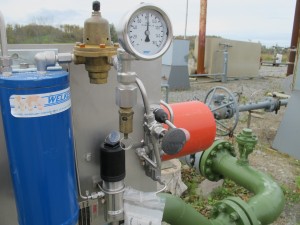Pennsylvania shale production continued to grow in 2013
-
Laura Legere -
Katie Colaneri

Marie Cusick / StateImpact Pennsylvania
Metering equipment at a producing gas well in Susquehanna County.
Pennsylvania’s annual gas production swelled last year, with drilling companies pulling 3.1 trillion cubic feet of gas from the Marcellus Shale and other unconventional formations in 2013, according to new data released by the state.
The production data is reported by operators and is not verified before it is posted online by the Department of Environmental Protection.
During the last six months of 2013, Pennsylvania’s shale wells produced 1.7 trillion cubic feet of gas, or an average of 9.2 billion cubic feet per day – enough to satisfy about an eighth of the nation’s daily natural gas demand. The U.S. Energy Information Administration said last week that it expects total natural gas consumption to average 70.2 billion cubic feet per day in 2014.
“It’s an incredible journey we’ve taken in a short period of time,” says David Spigelmyer, President of the Marcellus Shale Coalition.
Pennsylvania’s unconventional wells produced 21 percent more gas in the second half of 2013 than they did in the first half, when 1.4 trillion cubic feet of gas flowed from the state’s shale wells. Operators are becoming more efficient, pulling more gas from shale even as they deploy fewer drilling rigs in the state, and more pipelines are being built to carry the gas to customers. An average of 59 rigs were operating in Pennsylvania in 2013, down from 84 in 2012 and 110 in 2011, according to rig counts from the field services company Baker Hughes.
Working in the “sweet spot”
Northeastern Pennsylvania counties posted the largest production between July and December, with Susquehanna County producing the most gas, followed by Bradford and Lycoming counties in the northeast and Greene and Washington counties in the southwest.
Nearly half of the unconventional gas recorded during the period – 773 billion cubic feet – came from the 1,450 producing wells in Susquehanna and Bradford counties.
Seventeen of the 20 top producing wells for the period were Cabot Oil and Gas wells in Susquehanna County, known in the industry as the “sweet spot” where the Marcellus Shale is thickest.
“The fact that the county is very rural does allow us to work in cooperation with the local governments in placing our wells at the right location,” says Cabot spokesman George Stark. “But the facts are what belies Susquehanna County is the sweetest spot – that’s the real benefit of Susquehanna County.”
Stark says the company has one pad site with ten wells that produces enough gas to meet Philadelphia’s daily energy needs.
The top well, Cabot’s Empet D 8 in Harford Township, Susquehanna County, produced 4.2 billion cubic feet of gas over six months.
Unconventional gas production by county, July-December 2013:
[spreadsheet key=”0AlrF4wibqMprdHd1amEybFdGc3ZNVXQ3M1hZSHFUNFE&usp” source=”PA Department of Environmental Protection” filter=0 paginate=1 sortable=1]
















